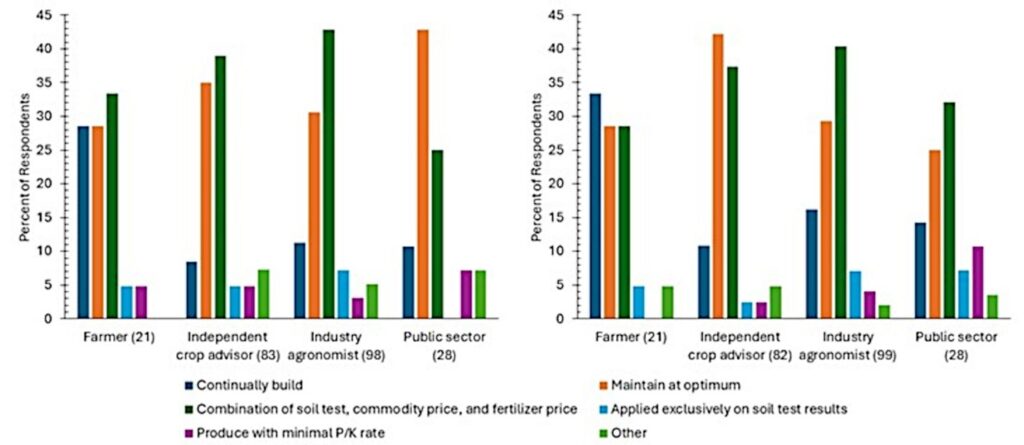Fact Sheet # 10: Stakeholder Perspectives on Soil Test-Based Fertilizer Recommendations
Soil testing and fertilizer management are at the core of modern agriculture. Most soil test correlation and calibration trials and the corresponding development of fertilizer recommendations occurred from the 1950s to 1970s. Despite many changes and advancements in agronomy and increases in crop yields, research on key soil fertility topics has not been conducted in many states. Today, the imperative of upgrading fertilizer and soil amendment recommendations is highlighted by variable on-farm economic conditions and concerns over the fate of fertilizer nutrients in the environment.
The Fertilizer Recommendation Support Tool project, or FRST, is a national initiative to modernize fertilizer recommendations by pooling expertise and soil test correlation and calibration data from across the country into an accessible decision support tool. Researchers working as a national team rather than within individual states and institutions will reduce ambiguity while optimizing soil amendment and nutrient use across state lines. FRST activities also include the improvement of soil acidity management and liming recommendations. The FRST tool and data generated by FRST activities are expected to augment existing recommendations with the potential to enhance soil and natural resource management, increase return on fertilizer and soil amendment investment by growers, and reduce nutrient losses to the environment.
The FRST team, in conjunction with Agricultural Laboratory Testing Association (ALTA) leadership, conducted a stakeholder survey to understand: 1) how stakeholders view soil testing as a component of P and K decision making, 2) the factors that contribute to lab selection for soil testing, 3) the drivers of P and K recommendations and decisions, and 4) key areas of development for the FRST tool, to support better adoption of science- based fertilizer P and K recommendations.
In 2024, a 23-question survey was distributed via X (Twitter), shared with FRST collaborators, and emailed to Certified Crop Advisors through the American Society of Agronomy. The survey results were summarized by categorizing respondents into four occupational groups: farmers (n = 21), independent crop advisors (n = 84), industry agronomists (n = 104), and public-sector professionals (n = 29).
Averaged across the four occupational groups, 91% of all respondents agree that soil testing is important for P and K fertilization decisions and 85% of respondents always use soil test information in making crop fertilization decisions. However, fewer than 10% of respondents in any occupational group reported relying solely on soil test results to guide P and K fertilization decisions (Figure 1).

Figure 1. Primary goal of phosphorus and potassium soil testing and fertilization for each of the four occupation groups. The number of respondents in each occupation is shown in parentheses.
Fertilization philosophy varied by occupation (Figure 1). About one-third of farmers report using a continual build strategy for soil-test P and K. In contrast, maintaining optimal soil test P and K levels or basing fertilization decisions on a combination of soil test data and economic factors were the dominant methods used by independent crop advisors and industry agronomists, and the public sector.
All occupation groups use a variety of information sources when making fertilizer recommendations. Critical soil test values (CSTV) and established crop response curves were less commonly used as compared to return on investment (ROI), crop nutrient removal estimates, and the probability of crop response. Public-sector professionals were the only group that reported using CSTV to drive fertilization decisions, and more so for P fertilization decisions than for K fertilization.
Key findings of the survey are that stakeholders often follow a continual build fertilization strategy, show limited trust or understanding of CSTVs, prioritize yield goals over soil test-based rates, and apply similar approaches to P and K management.
Special thanks to all survey respondents and our funders, USDA-NRCS (grants 69-3A75-17-45 & NR233A750011G016), USDA-ARS (grant 58-8070-8-016), and agInnovation via Hatch Funds provided by the National Institute of Food and Agriculture, U.S. Department of Agriculture for National Research Support Project 11.
For more detailed information
Bourns, M.A., Osmond, D.L., Slaton, N.A., Spargo, J.T., Gatiboni, L., Lacey, C., Sawyer, D., Yost, M., and Kaiser, D. (2025). Stakeholder engagement with soil testing: Practices and perspectives in U.S. agriculture. Agronomy Journal. Submitted
Bourns, M.A., Osmond, D.L., Slaton, N.A., Spargo, J.T., Gatiboni, L., Lacey, C., Sawyer, D., & Yost, M. (2025). Stakeholder engagement with soil testing: Practices and perspectives in U.S. agriculture [Data set]. Ag Data Commons. https://doi.org/10.15482/USDA.ADC/29656808
Authors: M. Bourns (Univ. of Arkansas), D. Osmond (NC State Univ.), N. Slaton (Univ. of Arkansas), L. Gatiboni (NC State Univ.), J. Spargo (Penn State Univ.), & M. Yost (Utah State Univ.). July 2025